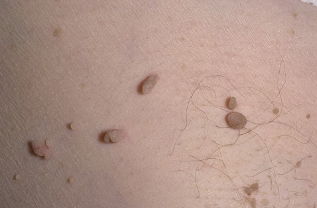Papilloma is a lesion of the mucous membrane caused by the skin and human mucosa.
causative agent - viruses of the genus Papilloma virus. Currently, more than 60 variants are known about them, 32 are identified as causing the disease.
Routes of transmission - contact (via skin microtema), genitalia, perinatal (in childbirth).
manifestations of papillomas

- cutaneous papilloma (warts).
is most often observed on the hands, less often on other parts of the body. Local lesions are common in children and adolescents. In immunocompromised patients, wartThe lesions may be extensive. The incubation period is 1–6 months. Maximum virus content in the affected tissues is noted 6 months after infection. - vulgar (simple) papillomas.
Their motive agent is human papillomavirus (HPV). This shape is manifested by rigid bumps with a tendency to merge onto a surface of 1 mm diameter or more. Vulgar papillomas often cover a large area. They can appear anywhere, but they are more often located behind the palms and fingers, in children - on the knees. A single papilloma can occur for several months or even years. , Practically unchanged, but the rapid spread of the process is also possible. There are isolated cases of papilloma degeneration in a tumor. Immunity contributes to the spread of the state process. - Plantar papillomas.
Motivational agents HPV-1 (darker form), HPV-2 (mosaic warts) and HPV-4 (minor lesions). The process begins with the appearance of a small, shiny bump. , Which acquires the characteristics of a typical papilloma, surrounded by a diffuse rim. Occasionally, around a papilloma, several putative structures appear, similar to bubbles - mosaic warts.
Plantar papillomas can be painful and make it difficult to walk. The duration of their existence is different. In some cases, especially in children, the spontaneous disappearance of any number of papillomas is possible. The form is often confused with calluses that appear on the fingers or in pressurized places between the fingers. Corns, unlike papillomas, have a smooth surface along the skin surface. - Flat papillomas.
Their motive agents are HPV-3 and HPV-10. They are represented by light skin bumps (light yellow or slightly colored) of normal skin color. They are round or polygonal in shape. The presence of flat papilloma, mainly in children, is usually accompanied by itching, swelling of the affected area, redness, sore throat.
. - filiform papillomas.
They are found in 50% of people over the age of 50 who are in armpits, in the waist, on the neck, around the eyes. The process of small yellow or slightly colored cones. Starts with appearance, then expands and bends in dense elastic structures, up to 5-6 mm in size. In places of potential trauma, papillomas may become inflamed. They do not disappear spontaneously. - local epithelial hyperplasia (Beck's disease).
Motivational agents 13 and 32 are human papillomaviruses. The disease was first described in American Indians. Small merging on the mucous membrane of the mouth, tongue, lips is seen as papillary eminence. - genital warts.
Motivational agents of genital warts are human papilloma virus of low (6, 11), moderate (31, 33, 35) and high (16, 18) oncological risk. Viruses are sexually transmitted. The incubation period lasts from several weeks to months. In some cases, the lesions are minimal, often unnoticed. Infected cells are prone to malignant degeneration. In most cases, a long and extensive processImmunodeficiency occurs with states.
Cervical cancer genital warts are most commonly found in women. In most cases, the viral genome is detected by DNA hybridization, regardless of the age of the patients. The causative agent HPV-Is 18. - Juvenile papillomatosis of the larynx.
Motivational agents are HPV-6 and HPV-11. They are rarely registered. In most cases, papillomatosis is detected in children under 5 years of age whoThe mother's births are infected in the canal. The presence of characteristic enlargement is seen on the molar cords, causing speech difficulties and impaired air circulation in the upper respiratory tract.
treatment of papilloma
Similar symptoms can be signs of various diseases, and the disease cannot proceed according to the textbook. Don't try to cure yourself - consult your doctor.
Currently, there is no unified international standard for the treatment of papillomas. In the official treatment guidelines so far,
Includes- cryo laser,
- electro destruction.
but they are not always effective and occur with relapses.
Other treatments for papilloma:
- for cutaneous and intractable (simple) papilloma - surgical removal (laser removal in combination with cryodetection, immune correction).
- for planter - cryodestriction, laser and / or diathermocoagulation.
- Mosaic papillomas are the most difficult to treat. Symptoms of inflammation are seen when they disappear, especially in children.
- for flat forms - cryotherapy with immune correction.
- for the conform - diathermocoagulation.
- For local epithelial hyperplasia, cryotherapy with immune correction.
- wart after improvement in immunity in case of dermal dysplasia, cryotherapy or diatharmocoagulation.
- For genital warts - cryo therapy, laser excision or removal of warts with diathermocoagulation and mandatory immune system improvement.
Treatment of genital papilloma can be difficult with other genital infections (chlamydia, bacterial vaginosis, herpes, CMV infection, etc. ). In these cases, treatment is done in parallel.














































































